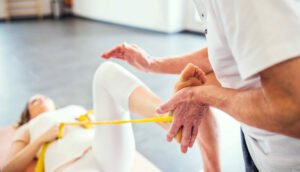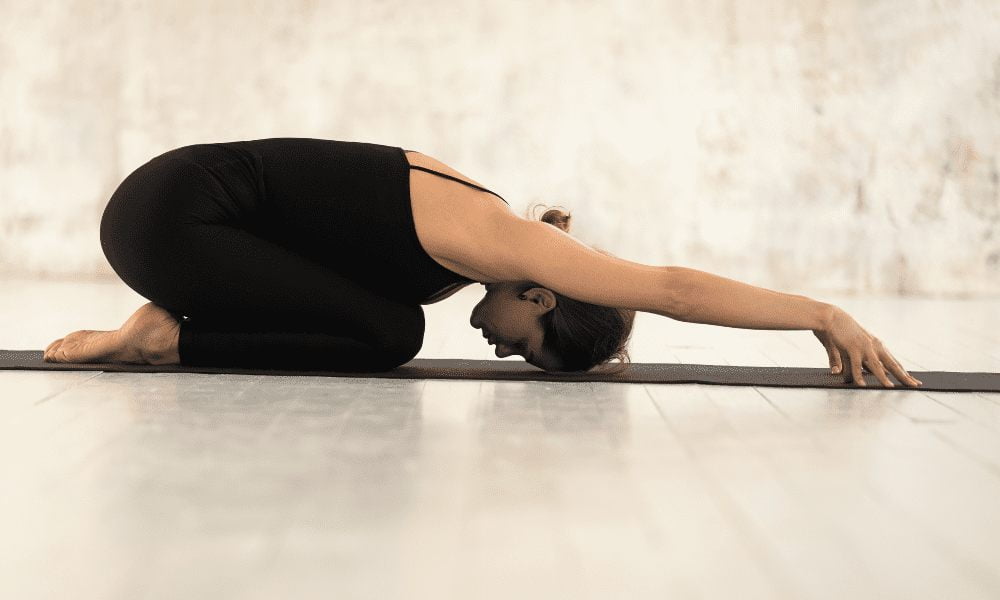Bulging discs are a common spinal condition that can lead to pain, discomfort, and limited mobility. While surgery and medication are sometimes recommended for severe cases, physical therapy for bulging discs emerges as a non-invasive and effective approach. This blog delves into the importance of physical therapy for bulging discs, offering insights, exercise suggestions, and more.
Contents
Can A Bulging Disc Heal With Physical Therapy?
 A bulging disc, which refers to a protrusion of the intervertebral disc beyond its usual boundary in the spine, can often benefit significantly from physical therapy. Physical therapy doesn’t necessarily “heal” the disc in the same way that a cut on your skin might heal. Instead, it aims to alleviate symptoms, improve spinal mechanics, and reduce the strain on the affected disc.
A bulging disc, which refers to a protrusion of the intervertebral disc beyond its usual boundary in the spine, can often benefit significantly from physical therapy. Physical therapy doesn’t necessarily “heal” the disc in the same way that a cut on your skin might heal. Instead, it aims to alleviate symptoms, improve spinal mechanics, and reduce the strain on the affected disc.
While physical therapy plays a pivotal role in managing and even reversing some of the symptoms associated with bulging discs, it’s also essential to note that each individual’s condition is unique. The effectiveness of physical therapy will depend on the severity of the bulging disc, its location, and the presence of any accompanying conditions. It’s always recommended to consult with a healthcare professional to determine the best approach for one’s specific condition.
What Are The Benefits of Choosing Physical Therapy?
Physical therapy (PT) is a vital component of the healthcare spectrum, offering a plethora of benefits tailored to individual needs. Here are some of the core benefits of choosing physical therapy:
- Non-Invasive Treatment
Unlike surgical interventions, physical therapy offers a non-invasive approach to treat many conditions. Also, it reduces the risks associated with surgery and often eliminates the need for it altogether.
- Pain Management
Through targeted exercises and manual therapy techniques, PT can help alleviate pain, reducing or even eliminating the need for pain medications, particularly opioids.
- Improved Mobility and Function
Whether it’s difficulty walking, standing, or moving, physical therapy can assist in restoring mobility. Ultimately, it makes daily tasks more manageable.
- Recovery from Injury or Surgery
PT plays an integral role in post-injury or post-surgical recovery. And, it will ensure that patients regain strength, flexibility, and function in the affected areas.
- Prevention
By identifying potential risk factors and addressing them proactively, physical therapy can prevent certain injuries or conditions from occurring or reoccurring.
- Enhanced Balance and Coordination
For those prone to falls or with balance disorders, PT offers exercises that improve coordination, proprioception, and balance, reducing the risk of falls.
- Avoidance of Opioids
In the wake of the opioid crisis, PT provides an alternative to pain management, addressing the root cause of pain rather than masking it.
- Improved Quality of Life
Ultimately, physical therapy aims to enhance the quality of life. Whether it’s allowing someone to play sports again, pick up their grandchild, or simply live without pain, PT plays a transformative role in many individuals’ lives.
Overall, physical therapy is a versatile, patient-centered approach that addresses the root causes of pain. And, offers lasting solutions and a proactive approach to health and well-being.
What Exercises Are Used In Physical Therapy for Bulging Discs?
 Physical therapy for bulging discs typically involves a combination of stretching, strengthening, and aerobic exercises. The goal is to alleviate pressure on the affected disc, improve spinal mobility, and strengthen the surrounding muscles for better support. Here’s a brief overview of some common exercises used for bulging discs:
Physical therapy for bulging discs typically involves a combination of stretching, strengthening, and aerobic exercises. The goal is to alleviate pressure on the affected disc, improve spinal mobility, and strengthen the surrounding muscles for better support. Here’s a brief overview of some common exercises used for bulging discs:
Pelvic Tilt
The pelvic tilt is a foundational exercise that focuses on improving the control and stabilization of the lower back and pelvis. By lying on your back with knees bent and feet flat on the floor, patients engage their core muscles, effectively tilting the pelvis and flattening the lumbar spine against the ground. This gentle movement not only strengthens the core but also promotes mobility and flexibility in the lumbar region, a key area affected by bulging discs.
Knee-to-Chest Stretch
This stretch aims to alleviate tension in the lower back. Starting in a supine position, the patient gently pulls one knee towards their chest using both hands, creating a stretch along the gluteal and lower back muscles. Holding this position for 15-30 seconds provides a gentle decompression effect, which can help relieve pressure from the affected disc.
Back Extensions
Specifically designed for the thoracic and lumbar regions, back extensions help promote a range of motion opposite to our usual forward-bent posture. Lying prone, the act of gently lifting the upper torso while keeping the pelvis grounded counters the typical forward-leaning positions that many adopt during daily activities. Regularly practicing this exercise can provide pain relief and strengthen the back muscles, offering more support to the spine.
Cat-Camel Stretch
This dynamic stretch, performed on all fours, is excellent for mobilizing the entire spine. The cat position, where the spine is arched upward and the head is tucked, stretches the muscles of the back. The camel position, where the spine dips down and the head lifts, focuses on the front of the torso. This alternating movement promotes flexibility, enhances blood flow, and reduces stiffness.
Bridge Exercise
An effective way to engage the glutes, hamstrings, and lower back muscles, the bridge exercise promotes lumbar stability. Starting in a supine position with knees bent, the lifting of the hips off the ground strengthens the posterior chain of muscles, which play a crucial role in supporting the spine, especially when compromised by a bulging disc.
Child’s Pose
A favorite in many yoga routines, the child’s pose offers deep relaxation and stretching for the entire back. By sitting back on the heels and reaching the arms forward, this position elongates the spine, providing relief and relaxation for areas affected by disc bulges.
Wall Sits
Engaging primarily the quadriceps, and wall sits also promotes endurance in the core and back muscles. By sliding down the wall into a seated position and maintaining it, this isometric exercise challenges the body’s stability and strength, promoting better posture and spinal alignment.
Partial Crunches
Unlike full sit-ups, partial crunches minimize the strain on the back while effectively targeting the abdominal muscles. With the lumbar spine grounded, the act of lifting the shoulders off the floor engages the core, strengthening the muscles that offer vital support to the spine, thereby reducing the load on bulging discs.
Hamstring Stretches
Tight hamstrings can exacerbate lower back pain. By gently stretching them, whether lying down or standing, one can alleviate some of the strain that tight hamstrings place on the pelvis and lower back. Using a towel or strap can assist in achieving a deeper stretch without straining.
Core Strengthening
Exercises like planks and side planks are advanced movements that focus on the deep muscles of the core. A strong core acts as a supportive corset for the spine, distributing loads effectively, and reducing the burden on discs, especially those that are bulging.
Always remember, that it’s vital for these exercises to be conducted under the watchful eye of a trained physical therapist. They will help to ensure safety and effectiveness.
Is Walking Good For L4 L5 Disc Bulge?
Walking is often recommended as a therapeutic activity for individuals with an L4-L5 disc bulge and for several good reasons. Firstly, walking promotes a neutral spine position. This can help reduce the pressure on the bulging disc and alleviate symptoms. The rhythmic motion of walking also enhances blood circulation to the spine. It is providing essential nutrients to the affected region and potentially speeding up the healing process.
Furthermore, walking engages the core and back muscles, albeit gently, reinforcing good posture and supporting the lumbar spine. However, it’s essential for those with an L4-L5 disc bulge to approach walking with some caution. The intensity, duration, and terrain should be taken into account.
Starting with short, slow walks on even surfaces and gradually increasing as tolerated is the recommended approach. Proper footwear that provides adequate support and cushioning can also make a significant difference. While walking is beneficial, it’s essential to listen to one’s body. If walking exacerbates pain or symptoms, it’s crucial to stop and consult with a healthcare professional or physical therapist.
How To Make the Most Out Of Your Physical Therapy Sessions?
 To ensure you receive the maximum benefit from your physical therapy sessions, a proactive and informed approach is essential. Here are some key strategies to make the most out of your physical therapy appointments:
To ensure you receive the maximum benefit from your physical therapy sessions, a proactive and informed approach is essential. Here are some key strategies to make the most out of your physical therapy appointments:
- Arrive Prepared
Wear comfortable and appropriate clothing that allows easy movement and provides the therapist access to the area being treated. Also, ensure you bring any necessary medical documents or previous reports.
- Set Clear Goals
Understand why you’re attending physical therapy. Are you aiming for pain relief, improving mobility, or rehabilitating after an injury? Discussing specific goals with your therapist can help tailor your treatment plan effectively.
- Ask Questions
Understand each exercise’s purpose, the mechanics behind them, and how they’re aiding your recovery. If something isn’t clear or feel uncomfortable, speak up. It’s crucial for your safety and progress.
- Practice At Home
Home exercises or “homework” are typically given to reinforce what you learn during therapy sessions. Regularly practicing these exercises can accelerate recovery and enhance the treatment’s effectiveness.
- Maintain a Regular Schedule
Consistency is key. Missing sessions or having erratic therapy schedules can hinder your progress. It’s essential to commit to the recommended frequency of visits for optimal results.
- Stay Engaged
Active participation, both mentally and physically, can significantly influence your outcomes. Be present, focus on your movements, and understand the importance of each activity.
- Stay Hydrated and Nourished
Physical therapy can be physically demanding. Ensuring you’re well-hydrated and nourished can aid muscle function and recovery.
- Build a Good Relationship with Your Therapist
A strong rapport with your physical therapist can make your sessions more productive. Trust, mutual respect, and open communication form the foundation of an effective therapy experience.
- Stay Positive and Patient
Physical therapy is often a journey with ups and downs. Maintaining a positive attitude, even when progress seems slow, can influence outcomes. Celebrate small milestones and trust the process.
By embracing these strategies, you can navigate your physical therapy sessions effectively, ensuring you’re on the best path toward recovery and improved well-being.
Conclusion
Physical therapy is a transformative journey, offering patients a non-invasive route to recovery, enhanced mobility, and pain relief. To maximize its benefits, it’s imperative to approach each session prepared, engaged, and informed. By setting clear goals, actively participating, and building a strong rapport with your therapist, you can ensure that each appointment brings you a step closer to achieving optimal health and well-being.
Remember, the key lies in consistency, feedback, and a positive attitude, ensuring that you harness the full potential of your physical therapy experience. Physical Therapy helps patients recover from pain. If you’re experiencing Back, Shoulder, Knee, Neck, Elbow, Hip, or Arthritis pain, a physical therapist at PhysioMantra can help: Book an online physical therapy session.



